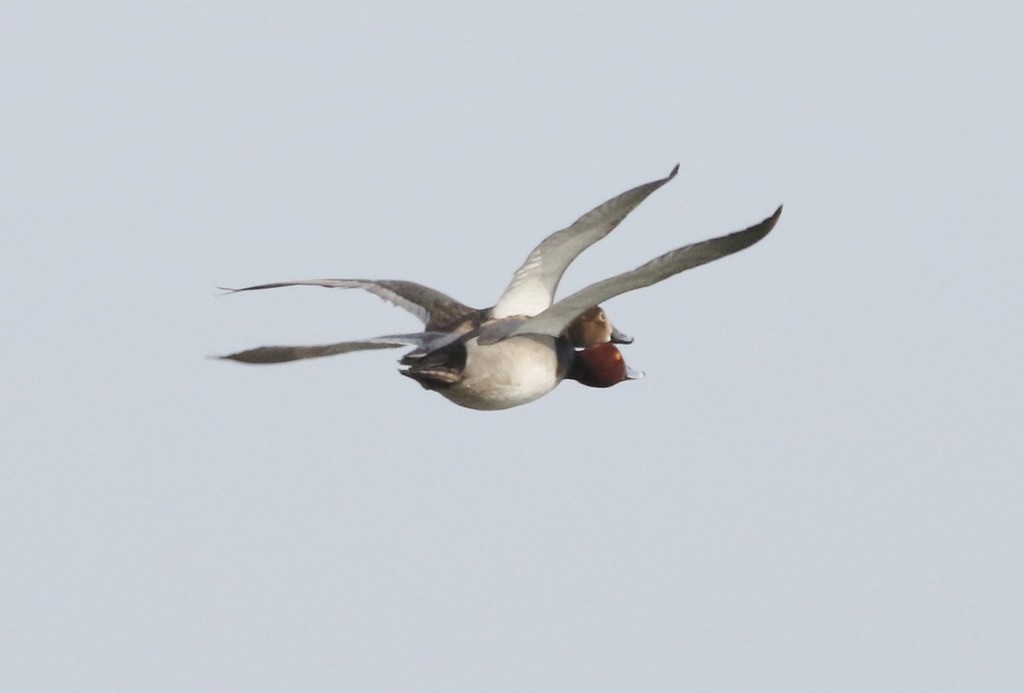Redhead
A species of Diving ducks, Also known as Red-headed Duck Scientific name : Aythya americana Genus : Diving ducks
Redhead, A species of Diving ducks
Also known as:
Red-headed Duck
Botanical name: Aythya americana
Genus: Diving ducks
 Photo By silversea_starsong , used under CC-BY-NC-4.0 /Cropped and compressed from original
Photo By silversea_starsong , used under CC-BY-NC-4.0 /Cropped and compressed from original Description
The redhead is easily recognized by its red head and neck. It's a lively bird, known for its quick flight and excellent swimming skills, and can be found in different types of wetlands. This duck is a true omnivore, feasting on both plants and animals, from aquatic vegetation to small fish, mollusks, and crustaceans. Its big appetite is also well-known, as it's been observed eating large amounts of food in a single meal. 
Size
46 - 56 cm
Colors
Brown
Black
Red
Gray
White
Life Expectancy
22.5 years
Nest Placement
Floating
Clutch Size
7 - 8 eggs
Number of Broods
22 - 28 days
Nestling Period
1 - 2 days
Feeding Habits
Redhead consume a mix of aquatic plants and animals. They feed on algae, pondweed, bulrush, and wigeon grass, also diving for snails, mussels, midges, and mayflies. While dabbling in shallows is common, they switch to more animal matter during breeding and primarily plant matter in winter.
Habitat
Redhead's primary habitat encompasses deep-water wetlands with dense emergent vegetation, typically found in prairie pothole regions. They breed in seasonal ponds and wetlands, with post-hatch residencies in deeper marshes or lakes. Molting occurs in southern boreal freshwater lakes, and migratory and wintering groups favor larger bodies of water, including river pools and bays in broader regions encompassing northern boreal forests and Gulf of Mexico shorelines.
Nest Behavior
Redhead selects the nest site from the air, builds solo, and uses local plants for construction. Egg-laying follows, and the female incubates alone, while the male may stay nearby until the eggs hatch.
Nest Characteristics
Redhead nests in marshes, among cattails and bulrushes, sometimes on muskrat houses. Constructed of surrounding vegetation with a feather lining, these circular nests can be up to 2 feet across and feature a cover or ramp of plants.
Dite type
Herbivorous
People often ask
Migration Overview
Spring Redheads leave their winter range in late January and February with all birds migrating by mid-March. In western North America, migrants begin arriving in Oregon, British Columbia] and Colorado in February. In central North America, migrants arrive as soon as temperatures open wetlands and lakes, which can range from late February (Nebraska) to early May (Alberta, Manitoba and Iowa). In the Great Lakes region and north-eastern North America, migrants will also arrive as soon as bodies of water open up. Fall Western birds migrate through Great Basin to the Pacific Coast. In British Columbia, fall migration begins in September and continues through October. The Great Salt Lake region is of particular importance to migrants in western United States. Central North American redheads will begin migrating earlier, around August/September and go through the Great Plains to the Texas coast. Eastern populations will migrate through the Great Lakes region to the Atlantic Coast or Florida from October to November. Most redheads winter along the Gulf of Mexico (offshore Louisiana, Florida and Mexico) however eastern populations will winter in South Carolina. 
General Info
Feeding Habits
Bird food type
Behavior
Redhead exhibit a sociable nature, often mingling with other waterfowl during feeding, utilizing a community approach to bring vegetation to the surface. They are notable for their fast and less predictable flight patterns. Redhead form pairs in winter and strengthen bonds during migration through display and vocalization rituals. Their distinctive “kink necked” display is unique in courtship. With seasonal monogamy, females exhibit diverse reproductive strategies, ranging from nurturing their offspring to egg parasitism or a mix of both, adapting to environmental conditions. Post-breeding, males join molting flocks as females incubate, signaling a change from their vibrant breeding attire to a subdued eclipse plumage.
Distribution Area
During breeding season, redheads are found across a wide range of North America, from as far north as Northern Canada to the Caribbean. Their preferred areas include the intermontane regions of British Columbia, Alberta, Saskatchewan, Manitoba, and the Dakotas with some small localities in Ontario, Quebec and southern United States. These pochards then migrate south to winter in warmer climates. These areas include southern United States where breeding does not occur and extends to Mexico, Guatemala, Cuba, and the Bahamas. In either season, redheads use wetlands as their main habitat. 
Species Status
Not globally threatened.